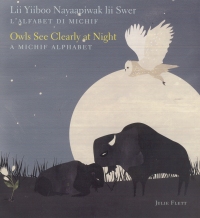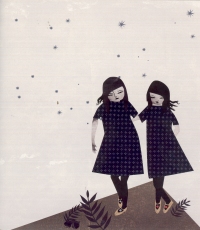| ________________
CM . . .
. Volume XVII Number 11. . . .November 12, 2010 
 |
Lii Yiiboo Nayaapiwak lii Swer: L'alfabet di Michif = Owls See Clearly at Night: A Michif Alphabet.
Julie Flett.
Vancouver, BC: Simply Read Books, 2010.
56 pp., hardcover, $18.95.
ISBN 978-1-897476-28-4.
Subject Headings:
Michif language-Alphabet.
Alphabet books.
Kindergarten and up / Ages 5 and up.
Review by Dave Jenkinson.
***½ /4
|
| |
|

excerpt:
A Atayookee!
Tell a story!
C Lii Chiiraañ
Northern lights
U Li Suyii Muu
Moccasins
Short-listed for the Governor General's Literary Award for Illustration, Owls See Clearly At Night is a bilingual alphabet book, with Michif, not English, being the book's primary language as Michif words are used to illustrate the letters of the alphabet.
Concerning Michif, an "Introduction" explains that:
The Métis culture, a mixture of First Nations (mostly the Cree and Ojibwe peoples) and European (mostly French and Scots people), have gone through many transformations since it began. The mingling of cultures resulted in the Michif language that is a unique blend of Cree (N'hiyaw'win) and French (Français) with some Saulteaux.
The Introduction goes on to explain that, while "Michif was once spoken by thousands of people across the Prairies of Canada and the Northern US," it is now an endangered language and is spoken only "in pockets of Manitoba, Saskatchewan, North Dakota, Alberta, Montana, and by other Métis communities spread across North America." According to the Introduction, "there has been a recent resurgence in interest in learning Michif and other Métis languages." Owls See Clearly at Night can be seen as a contribution to that revival attempt. To support the book's Michif language learning aspect, a "Vowel Pronunciation Guide" and a "Consonant Pronunciation Guide" are found at the book's conclusion, along with a page labelled "Resources" which is directed at those who want to learn more about the Michif language.
For those who are English speakers and have no interest in learning to speak Michif, it is most important to note that this alphabet book omits the letters q and x. Originally, Michif was just an oral language, and when attempts were made to represent the sounds of Michif in a written form, it was discovered that the letters q and x do not really represent any of the sounds heard in Michif. The introduction also clarifies that "whole sentences can quite often be expressed in one word in Michif, whereas in English this requires two or more [words]" as can be seen in the letter M:
M Mawishow
He/she is picking berries.
 Alphabet books are most often thought of as the stuff of preschoolers who are still learning the letters of the alphabet, their upper and lower case forms, and the sounds associated with the letters. Owls See Clearly At Night is clearly not such an alphabet book as it provides only the upper case form of just 24 letters of the English alphabet, and there are no sound connections between the letters and the English word(s). As can be seen in the Michif examples in the excerpt above, the focal letter of the alphabet does not necessarily appear as the first letter of the Métis word. Alphabet books are most often thought of as the stuff of preschoolers who are still learning the letters of the alphabet, their upper and lower case forms, and the sounds associated with the letters. Owls See Clearly At Night is clearly not such an alphabet book as it provides only the upper case form of just 24 letters of the English alphabet, and there are no sound connections between the letters and the English word(s). As can be seen in the Michif examples in the excerpt above, the focal letter of the alphabet does not necessarily appear as the first letter of the Métis word.
So, given its "shortcomings" as an alphabet book, why should you purchase Owls See Clearly At Night? If your school or library is in Western Canada, it is highly likely that you have some Métis children in your community, and they deserve to see their heritage represented in your collection. And, as the GG Award Committee pointed out, the illustrations are outstanding in their quiet simplicity. Each of the 24 letters is represented via a pair of facing pages with the lefthand page being given over to the very brief text. The facing page contains a spare, limited palette two-dimensional illustration which sometimes spills over onto the text page. The things/activities being illustrated are drawn from Métis culture, and so readers will see scenes from nature that include buffalos, pheasants and wild roses or items from Métis daily life, like canoes, moccasins and bannock. Illustrations also portray children engaged in activities such as jigging, picking berries and sledding.
Highly Recommended.
Dave Jenkinson, CM's editor, lives in Winnipeg, MB.

To comment
on this title or this review, send mail to cm@umanitoba.ca.
Copyright © the Manitoba Library Association. Reproduction for personal
use is permitted only if this copyright notice is maintained. Any
other reproduction is prohibited without permission.
NEXT REVIEW |
TABLE OF CONTENTS FOR THIS ISSUE
- November 12, 2010.
AUTHORS |
TITLES |
MEDIA REVIEWS |
PROFILES |
BACK ISSUES |
SEARCH |
CMARCHIVE |
HOME |

 Alphabet books are most often thought of as the stuff of preschoolers who are still learning the letters of the alphabet, their upper and lower case forms, and the sounds associated with the letters. Owls See Clearly At Night is clearly not such an alphabet book as it provides only the upper case form of just 24 letters of the English alphabet, and there are no sound connections between the letters and the English word(s). As can be seen in the Michif examples in the excerpt above, the focal letter of the alphabet does not necessarily appear as the first letter of the Métis word.
Alphabet books are most often thought of as the stuff of preschoolers who are still learning the letters of the alphabet, their upper and lower case forms, and the sounds associated with the letters. Owls See Clearly At Night is clearly not such an alphabet book as it provides only the upper case form of just 24 letters of the English alphabet, and there are no sound connections between the letters and the English word(s). As can be seen in the Michif examples in the excerpt above, the focal letter of the alphabet does not necessarily appear as the first letter of the Métis word.